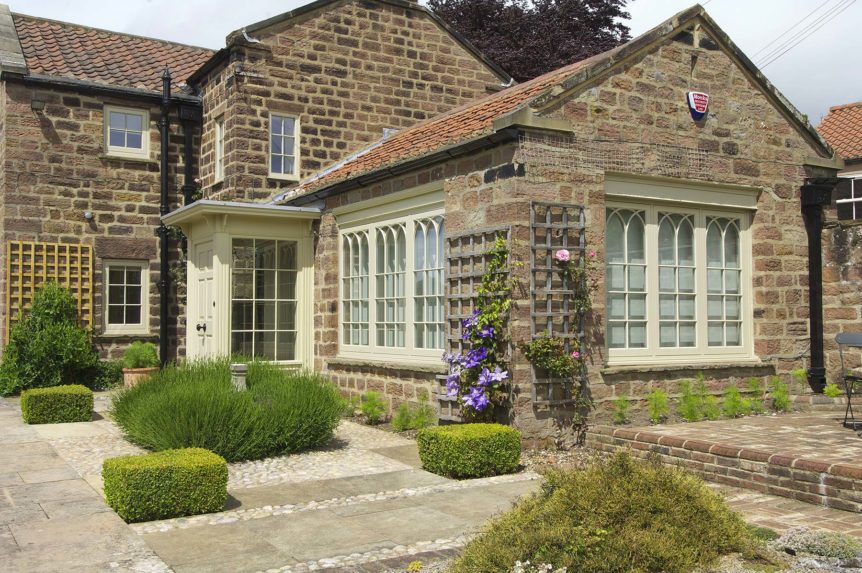A helpful GUIDE
So the time has come to redecorate your timber windows. This may be due to the lifespan of the paint coming to an end, or it may just be because you fancy a change in colour. What- ever your reason for redecorating your windows this helpful guide will help you get that near-factory finish once again.
WHAT YOU’LL NEED
- Fine sandpaper
- Glass cleaner
- Microfibre cloth Silicone gun
- Flexible polymer sealant Long bristle paint brush Paint (see beneath)
- Masking tape
IMPORTANT
It’s important to decide whether you’ll be redecorating your windows and doors yourself or whether you’ll be commissioning a decorator to carry out the work. Either way, the paint used MUST be a micro-porous, acrylic based system.
We recommend that Gori Teknos branded paints or stains are used when redecorating to achieve the closest match to the original finish; however most good quality micro- porous paint or stain systems will be suitable by following the manufacturer’s instructions.
Oil based non micro-porous paints will void the remaining warranty on your products
We will happily supply you with our Gori paint. Call us if you would like a quotation for this service or call down to the showroom to pick another colour if it’s a change you’re looking for.
TOP TIPS
Once you’ve completed the previous steps it’s time to have your paint brush at the ready.
- Beneath is a list of tips and tricks for best application.
- The quality of the brush is very important as short haired or worn brushes will leave lines in the paint.
- Prior to application, thoroughly wet the brush with water, ensuring that the base is fully wetted.
- Long haired synthetic brushes give the best application properties and are readily available from most DIY out- lets.
- An even coating film is important for durability and also for appearance, particularly in the case of translu- cent wood stain.
- When applying darker opaque colours over previously applied lighter shades, a base coat of the final colour will help achieve an even finish colour.
- Do not apply in extremes of temperature. The most suitable temperature range is between 5C and 15C. Humid conditions will prolong the “wet edge” time of the coating while warm windy conditions will reduce it.
- If possible avoid application in direct sunlight.
OUR step–by–step GUIDE
Give the window or door a quick wipe down with a damp cloth so you can care- fully inspect the condition of the existing paint. We recommend a light sand with a very fine sandpaper, something like a P320 finishing paper works wonders. Give the paint a light sand all over, paying particular attention to the more stubborn stains that have built up over the years.
Spray all over with a glass cleaner or use some water with a touch of detergent. Clean down thoroughly with a microfibre cloth, making sure to remove all of the dust and debris. Allow to dry completely before the next step.
If, during inspection, you find any cracks along joints or in the sealants it is important to fill these. Using a mastic gun, inject a flexible polymer sealant. Go sparing, you can always add more if necessary. Smooth flush with your finger. Make sure you seal around all areas where water may ingress into the timber.
We always recommend removing hard- ware and ironmongery where possible, it makes the decoration process easier and quicker. Any hardware that cannot be removed is best covered with a masking tape for ease.
Taping down the line of pointing or the line of sealant can speed up the process and leave a lovely straight edge once removed. Be careful not to leave the tape on for too long though as the glue will stick to the frame making it very difficult to clean.
If you’ve got a steady hand then you can paint down the glass line carefully to give a neat line. Failing this we would advise taping the glass too to give a superior finish.
THE actual DECORATION
For best results you should follow this handy application technique:
Load the coating generously and disperse quickly over the surface.
Even out the coating with light diagonal cross strokes. Do not overbrush; the coating will flow and level naturally.
Finish with light brush strokes in the direction of the grain.
Apply and finish each section systematically. This means painting a window or door one component at a time. E.g. Top Rail followed by a Stile followed by the Bottom Rail etc.
Allow your first coat to dry completely before applying a second. This process may take between 2 and 6 hours depending on temperature, humidity and wind.
Apply a second coat as above.
Remove all masking tape to reveal your beautiful, revital- ised windows and doors.
Coalescence (or curing) may take between a few days and a number of weeks depending on the conditions. During this curing process the paint film starts to chemically cross link, becoming less porous, and increasing toughness and adhesion. Paint your products at a time which allows the paint to cure properly.
CLEANING
Wash out brush with a mild detergent solution (e.g. wash- ing up liquid) and rinse with clean water.
Thank you for reading our helpful guide, we hope that you found it useful and feel prepared to take on the decora- tion of your lovely windows and doors.
This will help you with the basics of your window and door decoration but we strongly advise consulting the paint manufacturers instructions before carrying out the work.


